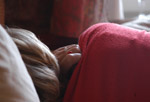 Daily exercise improves a teenager’s chances of a good night’s sleep, while excess computer time has the opposite effect, according to a national survey reported in the latest issue of the American Journal of Preventive Medicine. Earlier research has had similar findings, but this is the first large, nationally representative study to connect physical activity, sedentary behavior and sleep in high school students, explained Kathryn Foti, M.P.H.
Daily exercise improves a teenager’s chances of a good night’s sleep, while excess computer time has the opposite effect, according to a national survey reported in the latest issue of the American Journal of Preventive Medicine. Earlier research has had similar findings, but this is the first large, nationally representative study to connect physical activity, sedentary behavior and sleep in high school students, explained Kathryn Foti, M.P.H.
“The message for parents is that encouraging daily physical activity and limiting computer use outside of what’s necessary for schoolwork, can help students get the sleep they need,” Foti said. Foti is a health scientist at the Centers for Disease Control and Prevention’s (CDC) Division of Adolescent and School Health and lead author of the paper.
“It is a vital issue,” said Judith Owens, M.D., director of sleep medicine at Children’s National Medical Center in Washington, D.C. “Insufficient sleep increases the risk of obesity, affects academic performance and has implications for safety. Chronic sleep restriction affects the immune system, the developing brain and the cardiovascular system.” Many adolescents, she added, are “extremely sleep deprived.”
Analyzing data on nearly 15,000 high school students taken from the CDC’s biennial Youth Risk Behavior Survey, the researchers found that those who spent at least an hour engaging in physical activity daily were significantly more likely to report “sufficient” sleep — eight hours or more per night — than students who were inactive.
On the other hand, youths who devoted two hours or more to non-academic computer use or video games every day were less apt to sleep sufficiently than non-computer users.
The analysis also linked extensive TV watching — four or more hours daily—to sufficient sleep. “This is different from what we expected,” and contradicted earlier studies, Foti said. “It shows the need for further research.”
Future studies should also investigate the influence of other electronic devices, such as smart phones, and explore more deeply the mechanism through which physical activity and behavior influence sleep “in order to make more informed recommendations about how to help adolescents get enough sleep,” she said.
Owens called the correlation between physical activity and sleep particularly intriguing, but cautioned against inferring cause and effect. “More exercise may increase fatigue and make it easier to fall asleep, but getting more sleep may also make you less fatigued and more likely to exercise.”
Generally, self-reporting of sleep tends to be somewhat unreliable, she explained. “These findings are interesting, but we have to be cautious about drawing too many conclusions from a data set like this.”
Owens also questioned whether eight hours truly constituted sufficient sleep for teens, noting that other researchers had found that teens needed nine hours or more to be “optimally rested.”
Material adapted from Health Behavior News Service, part of the Center for Advancing Health.
No comments yet.